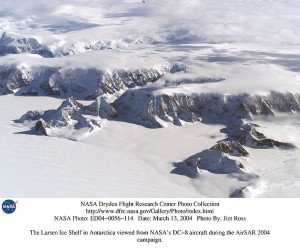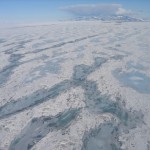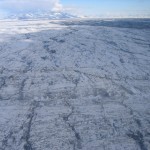What is an ice shelf? | Ice shelf collapse | Mechanisms of ice shelf collapse | Ice shelf buttressing | References | Comments
What is an ice shelf?

Ice shelves are floating tongues of ice that extend from grounded glaciers on land. Snow falls on glaciers, which flow downstream under gravity. Ice shelves are common around Antarctica, and the largest ones are the Ronne-Filchner, Ross and McMurdo Ice Shelves.
Ice shelves surround 75% of Antarctica’s coastline, and cover an area of over 1.561 million square kilometres (a similar size to the Greenland Ice Sheet). Ice shelves gain mass from ice flowing into them from glaciers onland, from snow accumulation, and from the freezing of marine ice (sea water) to their undersides[1]. They lose mass by calving icebergs, and basal melting towards their outer margins, along with sublimation and wind drift on their surfaces. Ice shelves are important, because they play a role in the stability of the Antarctic Ice Sheet and the ice sheet’s mass balance, and are important for ocean stratification and bottom water formation; this helps drive the world’s thermohaline circulation. Melting from beneath ice shelves is one of the key ways in which the Antarctic Ice Sheet loses mass[1].
In the satellite image of Prince Gustav Ice Shelf below, you can see that the ice shelves have a very flat appearance. In fact, you can normally tell where the ice starts to float by a sharp break in slope at the grounding line. Ice shelves are therefore composed of ice derived from snowfall on land, but they also accrete marine ice from below[2]. Ice shelves are therefore distinct from sea ice, which form solely from freezing marine water. You can see an example from northern Antarctic Peninsula below. Prince Gustav Ice Shelf was situated between Trinity Peninsula and James Ross Island. It collapsed in 1995. You can see glaciological structures on the ice shelf, indicating that it flows out from its tributary glaciers. You can also see abundant melt ponds on the ice shelf.
Ice shelves around Antarctica are up to 50,000 km2 in size, and can be up to 2000 m thick. Their front terminus is often up to 100 m high. Ice shelves intermittently calve large icebergs, which is a normal part of their ablation. Around Antarctica, ice shelves form where mean annual temperatures are less than -9°C, with sequential break up of ice shelves as temperatures increase[3-5]. The geometry of the coastline is often important for determining where ice shelves will develop. The Larsen Ice Shelf, for example, is formed in an embayment.
Ice shelf collapse
Several of the ice shelves around Antarctica have recently collapsed dramatically, rather than retreating in a slow and steady manner. Larsen A collapsed in 1995[6], and Larsen B Ice Shelf famously collapsed in 2002. It has shrunk from 12,000 km2 in 1963 to 2400 km2 in 2010[4]. During February 2002, 3250 km2 were lost through iceberg calving and fragmentation. In the figure below, you can see the blue, mottled appearance of the ice shelf in the 2002 image, caused by the exposure of deeper blue glacier ice.

Several ice shelves have now collapsed around the Antarctic Peninsula (Table 1). Their collapse has made it possible to core the sub-shelf sediments to investigate whether these collapses are part of normal ice-shelf behaviour. It appears that the more northerly ice shelves, such as Prince Gustav Ice Shelf, have indeed previously collapsed, resulting in open-marine organisms living in Prince Gustav Channel for a short period 5000 years ago[7]. However, the more southerly Larsen B Ice Shelf appears to have remained a fixture throughout the Holocene[8]. This suggests that certain thresholds have been passed, with environmental changes throughout the Antarctic Peninsula now surpassing any that have occurred before.
In the video below, you can see an animation of the Larsen Ice Shelf collapse from Modis imagery:
Table 1. Dates of ice shelf collapse
| Ice shelf | Largest area (km2) | Previous behaviour | Recent behaviour |
| Wordie | 2000 | ??? | 1989 collapse |
| Larsen Inlet | 400 | Frequent removal throughout Holocene | 1989 collapse |
| Prince Gustav | 2100 | Removal 5000 BP | 1995 collapse |
| Larsen A | 2500 | Frequent removal throughout Holocene | 1995 collapse |
| Larsen B | 11,500 | Stable throughout Holocene | 2002 collapse |
| Jones | 25 | ??? | 2003 collapse |
| Wilkins | 16,577 | Numerous large calving events | 2008 collapse |
| Larsen C | 60,000 | Stable throughout Holocene | Thinning & retreating |
| Müller | 50 | Advance during the Little Ice Age | Gradual recession (50 % left) |
| George VI | 26,000 | Brief absence (9000 BP) | Still present & thinning. Confined, which may increase stability. |
Mechanisms of ice shelf collapse
There are several reasons why ice shelves disintegrate rapidly rather than slowly and steadily shrinking. Ice shelves collapse in response to long term environmental changes, which cause on-going thinning and shrinking. When certain thresholds are passed, catastrophic ice shelf disintegration through iceberg calving is initiated. Before collapse, ice shelves first undergo a period of long-term thinning and basal melting, which makes them vulnerable. Meltwater ponding on the surface and tidal flexure and plate bending then all contribute to rapid calving events and ice shelf disintegration.
1. Long term thinning and basal melting

(Pritchard et al. 2012), copyright (2012).
Long-term thinning from surface and basal melting preconditions the ice shelf to collapse. Negative mass balances on tributary glaciers can lead to thinning of the glaciers and ice shelves. The highest rates of thinning are where relatively warm ocean currents can access the base of ice shelves through deep troughs[9,10]. Ice-shelf structure seems to be important, with sutures between tributary glaciers resulting in weaker areas of thinner ice, which are susceptible to rifting[11].
A recent analysis of ice shelves across Antarctica has shown that basal melt rates are around 1325 ± 235 gigatonnes per year, with an additional calving flux of 1089 ± 139 gigatonnes per year. Ice shelf melting is therefore one of the largest ablation processes in Antarctica[1]. However, this massive basal melting does not occur evenly distributed across all ice shelves; the massive Ronne, Filchner and Ross ice shelves cover two thirds of the total ice shelf area but account for only 15% of net melting. Instead, the highest melt rates occur around the Antarctic Peninsula and West Antarctica, from the northern end of George VI Ice Shelf to the western end of Getz Ice Shelf[1]. These ice shelves are also rapidly thinning rapidly[9]. On slow moving ice shelves (e.g., George VI, Abbot, Wilkins), almost all of the original land ice has melted away within a few kilometres of the grounding line. So, half of the meltwater produced comes from just ten small, warm-cavity ice shelves around the SE Pacific rim of Antarctica, and these ten ice shelves occupy just 8% of total ice shelf area. All this cold water being released into the ocean has a significant impact on the formation of sea ice, resulting in higher rates of sea ice concentration around Antarctica.
Melting of ice shelves around Pine Island Glacier in West Antarctica is concerning, because the West Antarctic Ice Sheet is grounded below sea level. A collapse of this ice shelf could lead to marine ice sheet instabilty and rapid global sea level rise.

2. Surface melting and ponding
Increased atmospheric temperatures lead to surface melting and ponding on the ice surface. Catastrophic ice-shelf collapsed tend to occur after a relatively warm summer season, with increased surface melting[12]. Based on the seasonality of ice shelf break up, and the geographic distribution of ice shelf collapse near the southerly-progressing -9°C isotherm, it appears that surface ponding is necessary for ice-shelf collapse[12]. This meltwater melts downwards into the ice shelf, causing fractures and leading to rapid ice-berg calving[5, 12]. Increased surface meltwater also leads to snow saturation, filling crevasses with water and increasing hydrostatic pressures. Brine infiltration can also cause crack over deepening.
3. Plate bending and tidal flexure
However, meltwater ponding alone does not explain rapid ice-shelf fragmentation. We need to invole a third process. Bending at the frontal margin of the ice shelf as a result of tidal flexure may cause small cracks to form parallel to the ice front. When subject to the above conditions (thinning with abundant surface water), a threshold may be passed, causing rapid ice shelf disintegration[12].
When icebergs are formed through the above mechanisms, long, thin icebergs are formed at the ice front. These icebergs will capsize as they are thinner than they are deep. Iceberg capsize releases gravitational potential energy and increases tensile stress on the ice shelf. This may lead to a cascade of fragmentation, capsize, and iceberg break up[13].
Ice shelf buttressing

Collapsing ice shelves do not directly contribute to global sea level rise. This is because they are floating, and so their melting does not result in sea level rise. To check this, put a few ice cubes in a glass and check the water level. Does the water rise when the “icebergs” melt?
However, ice shelves play a very important role in “buttressing” their tributary glaciers. Glaciers that feed into ice shelves are held back by the ice shelf in front of them[14, 15]. Even small ice shelves play an important role in regulating flow from ice streams that feed into them[14]. This has been observed in several cases, most notably following the Larsen Ice Shelf [16-19] and Prince Gustav Ice Shelf collapses[20, 21]. In the Landsat image of Prince Gustav Ice Shelf above, you can see the rapid glacier recession from 1988 to 2009.
With glaciers thinning, accelerating and receding in response to ice shelf collapse[20, 21], more ice is directly transported into the oceans, making a direct contribution to sea level rise. Sea level rise due to ice shelf collapse is as yet limited, but large ice shelves surrounding some of the major Antarctic glaciers could be at risk, and their collapse would result in a significant sea level rise contribution[22]. See Marine Ice Sheet Instability for more information.
Further reading
- Marine Ice Sheet instability
- George VI Ice Shelf
- Ice shelves: the hidden villan
- Sea level rise
- Glacier recession in Patagonia
- Glacier recession on the Antarctic Peninsula
- Glaciers and climate change
- Antarctica’s contribution to global sea level rise
- The growing rift on Larsen C Ice Shelf
Go to top or jump to Marine Ice Sheet Instability.
Go to top or jump to Marine Ice Sheet Instability.





Pingback: Prat watch #7.5: No, you’re not entitled to your opinion
Pingback: Antarctic ice shelf disintegrating (2008 footage) | Clearing House for Environmental Course Material
Pingback: Antarctic ice shelves and sea ice – a tale of two parts - AntarcticGlaciers.org
Pingback: The A to Z of Antarctica - AntarcticGlaciers.org
Very nicely written description, just one question: It is stated that “ice shelves collapse in response to long term environmental changes”. No doubt environmental changes have some effect on the rate of collapse, but do they not collapse at all when the environment is steady?
If you think of loss of South coast (of England) cliffs due to seawater erosion then surely that happens all the time (mostly from storms), not just when the environment changes.
Hi Mikky,
Thanks for your comment.
It’s important to remember that the processes involved in coastal erosion and ice-shelf collapse are very different!
Ice shelf collapse needs some trigger. In numerical models initiated under stable conditions, ice shelves do not develop some kind of physical instability and spontaneously collapse. They calve icebergs in response to numerous external pressures. Also, we don’t live in a world where the environment is steady.
Around the Antarctic Peninsula, changes in ocean currents, and in particular, changes in circumpolar deep water flowing onto the continental shelf, is melting ice shelves from below. When this is combined with rapid surface melt during warm summers, the ice shelves can disintegrate very quickly. We can look at marine sediment cores to see if this is an unusual or normal occurrence. It seems that more northerly ice shelves around the northern Antarctic Peninsula (Prince Gustav, Larsen A) and on the western peninsula (George VI Ice Shelf), may have disintegrated previously during warm phases in the Holocene. However, some ice shelves such as Larsen B appeared to be stable for most of the Holocene.
you miss spelled was wrong near the top you put “ws”
Thank you – typo corrected
Thanks for the clear info, discussed in a nonsensational matter-of-factly manner.
looking at the images above it seems that ice pieces, short after collapse. move in North-west direction
Similar phenomena, in the arctic, generate movement in south-west direction.
Is it possible that ice shelfs are exposed to the corioli effect?
It generate tensions that explode when the ice structure is thinning.
Ice shelfs are huge masses, exposed to tensions due to the rotation of the earth. These tensions are not mitigated by contact with the soil.
Instead they are accumulated by a support of water that is practical neutal in respec to that forces.
thanks,I learnt a lot
Thanks for making this, it helped with my school presentation I had to do.
me too!1
I am currently working on a dissertation on this subject, and am using your page to help me in my layout. I was just wondering if the image you used for the basal melting was found somewhere, or if you made it yourself. If you made it yourself, what package did you use, if MATLAB, would love to see your coding so I can adapt it for the Filchner- Ronne Ice Shelf.
Thanks
Dear Jodie, the images are credited if I did not make them, and the images I made were made in Illustrator or ArcGIS. Thank you, Bethan
Pingback: Is the Largest Antarctica Iceberg Breaking Free:Sign of Climate Change?